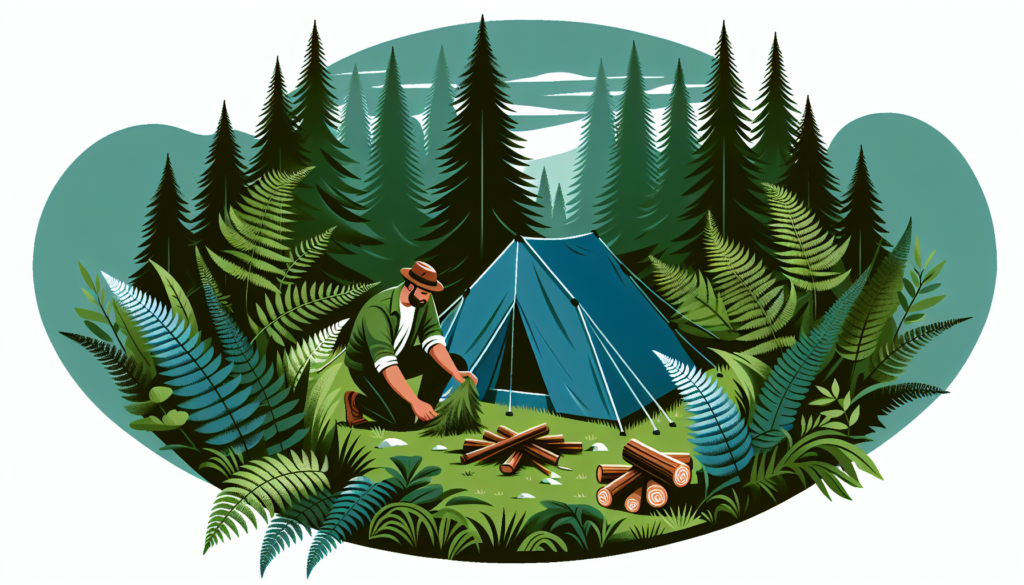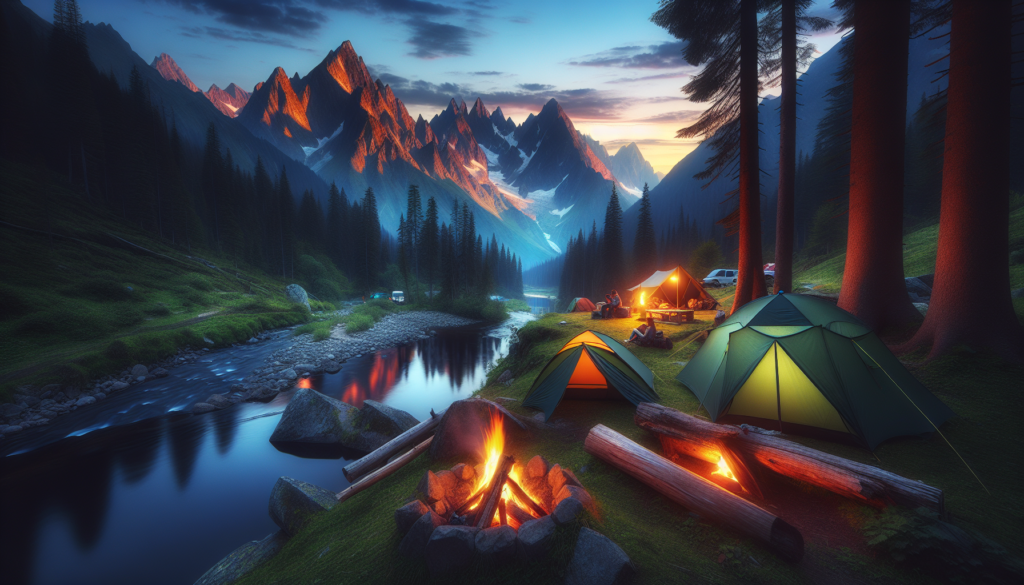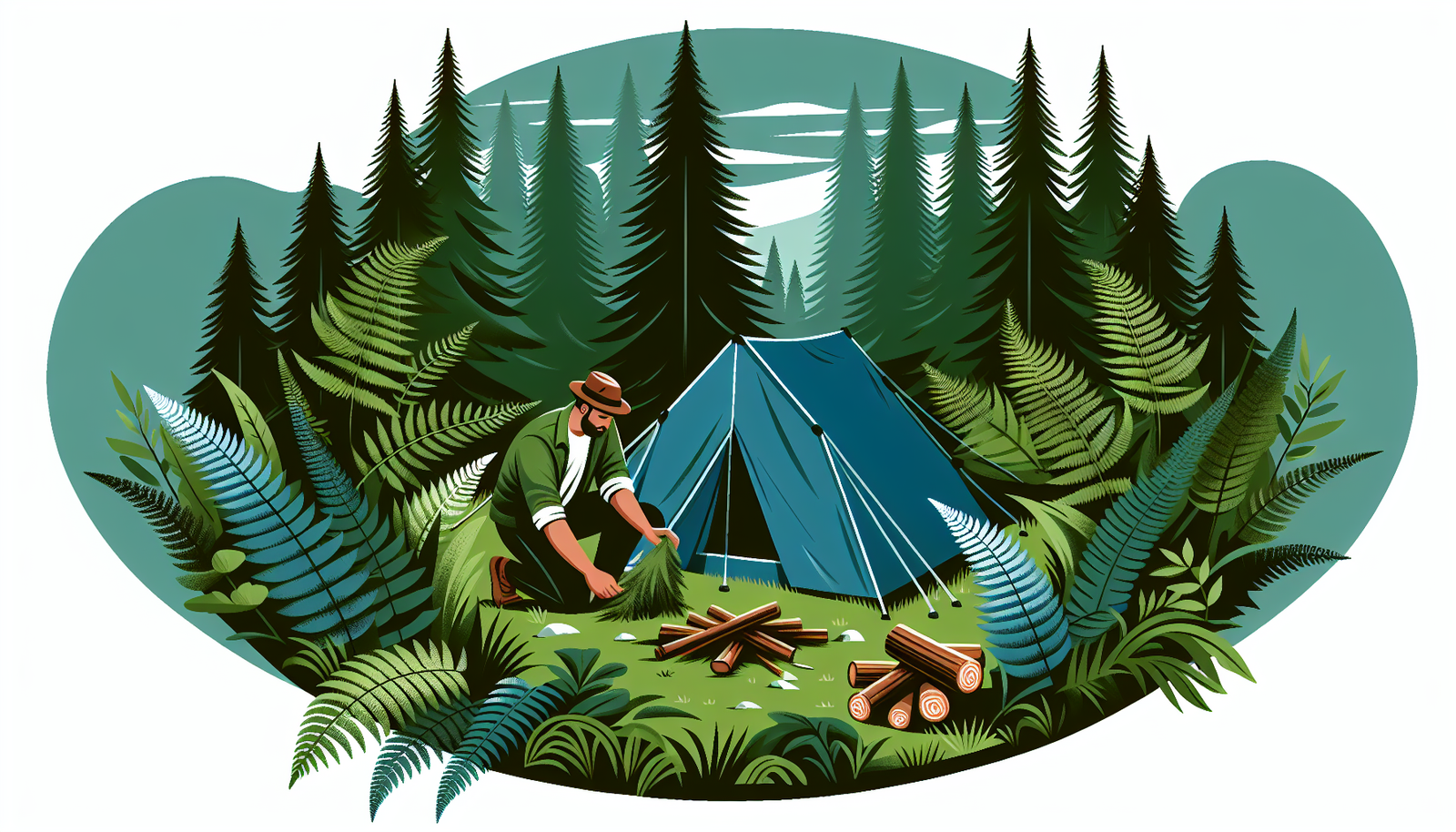Imagine finding yourself in the heart of a pristine wilderness, surrounded by breathtaking landscapes and untouched nature. As you embark on your adventure, the question arises: what is the best way to set up camp in such remote areas? In this article, we will guide you through the essentials of creating a comfortable and secure camping experience away from the conveniences of modern civilization. From choosing the ideal campsite to mastering the art of food storage, we will help you make the most of your outdoor retreat. So pack your gear, embrace the spirit of exploration, and let’s discover the best practices for setting up camp in remote areas.
Choosing the Right Location
When setting up camp in remote areas, it is crucial to choose the right location. Several factors should be considered to ensure a safe and comfortable camping experience.
Consider the Terrain and Climate
Before selecting a campsite, it is essential to consider the terrain and climate of the area. Is the ground rocky or flat? Is the area prone to flooding or strong winds? These factors will help determine the suitability and stability of the location. Additionally, understanding the climate will guide your decision on appropriate gear and clothing to pack.
Check for Water Sources
Access to water is vital when camping in remote areas. Before settling on a campsite, make sure to check for nearby water sources such as rivers, lakes, or streams. This will provide you with the necessary water for drinking, cooking, and cleaning, ensuring your basic needs are met during your camping trip.
Look for Level Ground
Finding level ground is crucial for setting up your tent and ensuring a good night’s sleep. Avoid sloping areas as they can lead to discomfort and potentially unsafe sleeping conditions. Look for flat ground that is free from rocks, roots, or any other obstacles that may affect your tent’s stability or your comfort.
Evaluate Safety and Security
When camping in remote areas, it is important to prioritize safety and security. Consider the potential risks in the area, such as wildlife encounters or harsh weather conditions. Choose a location that provides adequate distance from potential hazards, or take necessary precautions such as bear-proof food storage or setting up camp away from animal trails.
Setting Up Shelter
Setting up shelter is one of the most critical aspects of camping in remote areas. It provides protection from the elements and a comfortable place to rest during your outdoor adventure.
Types of Shelter
There are various types of shelter to consider when camping in remote areas. The most common options include tents, tarps, hammocks, or building a natural shelter using available resources. Each option has its advantages and disadvantages, so it is important to choose the one that best suits your needs and the conditions of your camping destination.
Tents: Size and Material
When selecting a tent, consider the size and material that will best accommodate your needs. If you are camping alone or with a partner, a smaller tent may be sufficient. However, if you are camping with a larger group or if you prefer additional space, a larger tent may be necessary. Additionally, consider the material of the tent, ensuring it is durable and suitable for the climate conditions you will encounter.
Tarps and Hammocks
For more lightweight and minimalist options, tarps and hammocks can be excellent choices for shelter in remote areas. Tarps provide protection from rain and wind while taking up minimal space in your backpack. Hammocks offer a unique camping experience, allowing you to sleep comfortably off the ground while taking advantage of natural elements.
Building a Natural Shelter
In some cases, it may be necessary to build a natural shelter using the resources available in the surrounding environment. This can involve constructing a lean-to or using fallen branches and leaves to create a makeshift shelter. It is important to have the necessary knowledge and skills to build a safe and effective natural shelter.

Fire and Cooking
Fire is not only crucial for warmth and comfort in remote camping areas but also for cooking meals and boiling water. Proper fire management and cooking techniques are essential for a successful and enjoyable camping experience.
Building a Fire Pit
When setting up a fire pit, it is important to choose a safe location. Select an area away from flammable materials such as dry grass or overhanging branches. Clear the area of debris and create a circle with rocks to contain the fire. This will help prevent the fire from spreading and ensure safety.
Gathering Firewood
Before starting a fire, gather an adequate amount of firewood. Look for fallen branches or dead wood, avoiding live trees or standing deadwood, as they may harm the environment or pose safety risks. Ensure you have enough firewood to last throughout the night and consider using local regulations regarding firewood collection.
Cooking Equipment
Choosing the right cooking equipment is essential for preparing meals while camping in remote areas. Portable stoves, campfire grills, or Dutch ovens are popular options for outdoor cooking. Consider the size and fuel requirements of the equipment, ensuring they align with your cooking needs and the available resources.
Safety Measures
When dealing with fire and cooking in remote areas, it is crucial to prioritize safety. Always keep a bucket of water or a fire extinguisher nearby in case of emergencies. Never leave a fire unattended, and be sure to fully extinguish the flames before leaving the campsite or going to bed. -Remember to follow any local regulations or fire restrictions that may be in place in the area you are camping.
Water and Hygiene
Water is a fundamental resource for survival, and maintaining proper hygiene is essential for a safe and comfortable camping experience in remote areas.
Water Purification Methods
When camping in remote areas, it is essential to properly purify any water you collect from natural sources. Boiling water for at least one minute is a reliable method to kill harmful microorganisms. If boiling is not possible, using water filters, purification tablets, or UV sterilizers are effective alternatives. It is important to follow the instructions provided with these purification methods to ensure their effectiveness.
Collecting Water
Identifying and collecting water sources in remote areas is crucial for hydration and other camping needs. Carry water containers or packs that have adequate capacity to hold enough water for your planned activities. Be mindful of the cleanliness of the water source and take precautions to collect water from areas that are less likely to be contaminated.
Sanitation and Waste Disposal
Maintaining proper sanitation and waste disposal practices is imperative when camping in remote areas. Always pack out any trash or waste generated during your camping trip and dispose of it appropriately when you reach civilization. It is also crucial to practice good hygiene by properly washing your hands and disposing of human waste responsibly, following the principles of Leave No Trace.

Food Storage
Proper food storage is essential when camping in remote areas to prevent attracting wildlife and to keep your food safe and secure.
Keeping Food Secure
To keep your food secure and protect it from wildlife, it is important to store it properly. Use sturdy containers or coolers that are resistant to wildlife attempts to access the food. Avoid storing food inside your tent, as this may attract animals and put you at risk. Consider using bear canisters or bear bags, or hanging your food from trees using proper techniques.
Using Bear Canisters or Bear Bags
In areas with a high risk of bear encounters, it is important to use bear canisters or bear bags to store your food. These containers are designed to be bear-resistant, reducing the chances of attracting these animals to your campsite. Follow the manufacturer’s instructions when using bear canisters or hanging food bags, ensuring they are properly sealed and at a safe distance from your sleeping area.
Hanging Food from Trees
If bear canisters or bear bags are not available, it is possible to hang food from trees using proper techniques. Choose a sturdy tree branch at least 10 feet above the ground and 4 feet away from the trunk, away from any other branches or objects that may aid animals in accessing the food. Use a rope or cord to hang the food bag, ensuring it is at least 6 feet away from the trunk and away from the reach of any animal.
Lighting and Navigation Tools
When camping in remote areas, proper lighting and navigation tools are essential for safety and convenience.
Headlamps and Flashlights
Headlamps and flashlights are indispensable tools for camping in remote areas, providing reliable lighting during the night. Choose high-quality and durable headlamps or flashlights that have a long battery life and are resistant to water and impact. These tools will help you navigate your campsite, find your way to the bathroom at night, or signal for help if necessary.
Navigation Tools: Maps and Compasses
Having proper navigation tools such as maps and compasses is crucial when camping in remote areas. Familiarize yourself with the area before your trip, and carry detailed maps that provide accurate information about the terrain, trails, and landmarks. Additionally, learn how to use a compass to orient yourself and navigate through unfamiliar territory.
Solar or Battery-powered Lanterns
Solar or battery-powered lanterns are practical alternatives to light up your camping area during the evening. Solar-powered lanterns harness the energy of the sun during the day, while battery-powered lanterns provide reliable light with replaceable batteries. Consider the duration of your camping trip and the availability of sunlight when choosing which option suits your needs.
Sleeping Comfortably
A good night’s sleep is vital when camping in remote areas to ensure physical and mental well-being during your outdoor adventure.
Sleeping Bags and Mats
A comfortable sleeping bag and a sleeping mat are essential for a restful sleep in remote camping areas. Choose a sleeping bag that suits the expected temperature range, considering factors such as insulation, weight, and packability. Additionally, invest in a sleeping mat that provides cushioning and insulation from the cold ground, enhancing your overall sleeping comfort.
Choosing the Right Sleeping Gear
When selecting sleeping gear for camping in remote areas, consider factors such as insulation, breathability, and moisture-wicking properties. Choose appropriate materials that will keep you warm in cold temperatures and cool in hot weather. Additionally, ensure that your sleeping gear is lightweight and easily packable, allowing for easy transportation during your outdoor adventures.
Insulation and Protection
To increase insulation and protection from the elements, consider using additional layers such as sleeping bag liners or bivy sacks. These extra layers can provide additional warmth, moisture resistance, and protection from insects or other outdoor pests. Choose options that are lightweight and compatible with your sleeping bag for optimal comfort and ease of use.
Clothing and Gear
Choosing the right clothing and gear is crucial for comfort and safety when camping in remote areas.
Layering Clothing
Layering clothing is an effective way to regulate body temperature in remote camping areas. Select moisture-wicking base layers that can keep you dry and comfortable, insulation layers to provide warmth, and outer layers that are waterproof and windproof. This allows you to adjust your clothing based on changing weather conditions and activity levels throughout the day.
Choosing the Right Footwear
Proper footwear is essential for navigating remote areas and ensuring foot protection and comfort. Choose sturdy hiking boots or shoes that provide ankle support, traction, and water resistance. Consider the terrain and weather conditions of your camping destination when selecting the appropriate footwear.
Essential Camping Gear
Certain camping gear is essential for a comfortable and enjoyable experience in remote areas. Items such as a reliable backpack, camping stove, camping utensils, multipurpose knife, first aid kit, and a water filtration system should be included in your camping checklist. Assess your needs and select the necessary gear that will enhance your camping experience and ensure your safety.
Backpack Considerations
When choosing a backpack for camping in remote areas, prioritize comfort, durability, and functionality. Consider the size and capacity of the backpack, ensuring it can accommodate all your necessary gear and supplies. Look for backpacks with adjustable straps, padded hip belts, and proper weight distribution systems to minimize strain on your body while hiking or carrying heavy loads.
First Aid and Emergency Preparation
Being prepared for emergencies is essential when camping in remote areas. A well-stocked first aid kit and emergency communication devices are crucial in case of unexpected situations.
First Aid Kit Essentials
A comprehensive first aid kit is a must-have when camping in remote areas. Ensure your kit includes items such as bandages, antiseptic solution, adhesive tape, pain relievers, insect repellent, tweezers, and any necessary personal medications. It is vital to know how to use the items in your first aid kit and regularly check the contents for expiration dates or replenish as needed.
Emergency Communication Devices
Having reliable communication devices is essential for emergency preparedness in remote camping areas. These devices can include mobile phones, satellite phones, two-way radios, or personal locator beacons (PLBs). Familiarize yourself with their functioning and availability of coverage in your camping area. Ensure they are fully charged and accessible at all times, ready to be used in case of emergencies.
Leave No Trace Principles
When camping in remote areas, practicing Leave No Trace principles is vital to minimize your impact on the environment and preserve the beauty of nature for future generations to enjoy.
Minimize Campfire Impact
While campfires may be enjoyable, it is important to minimize their impact on the environment. Respect any fire regulations in the area and opt for using established fire pits when available. Keep fires small and only use dead or downed wood. When extinguishing the fire, ensure it is completely out by pouring water on it and scattering the ashes.
Pack It In, Pack It Out
One of the key principles of Leave No Trace is to pack out all your trash and waste. Leave your campsite as clean as you found it, and avoid burying or burning trash, as these can have long-lasting impacts on the environment. Bring reusable containers for food and leave unnecessary packaging at home to minimize waste generation.
Respect Wildlife
When camping in remote areas, respect the wildlife that inhabits the surroundings. Keep a safe distance from animals and observe them from afar. Do not feed or approach wildlife, as this can disrupt their natural behavior and potentially harm both humans and animals. Learn about local wildlife and follow any regulations or guidelines provided to ensure their safety and conservation.
In conclusion, setting up camp in remote areas requires careful consideration of various factors such as location, shelter, fire and cooking, water and hygiene, food storage, lighting and navigation tools, sleeping comfort, clothing and gear, first aid and emergency preparation, and practicing Leave No Trace principles. By following these guidelines and being prepared, you can enjoy a safe and memorable camping experience in the great outdoors.

